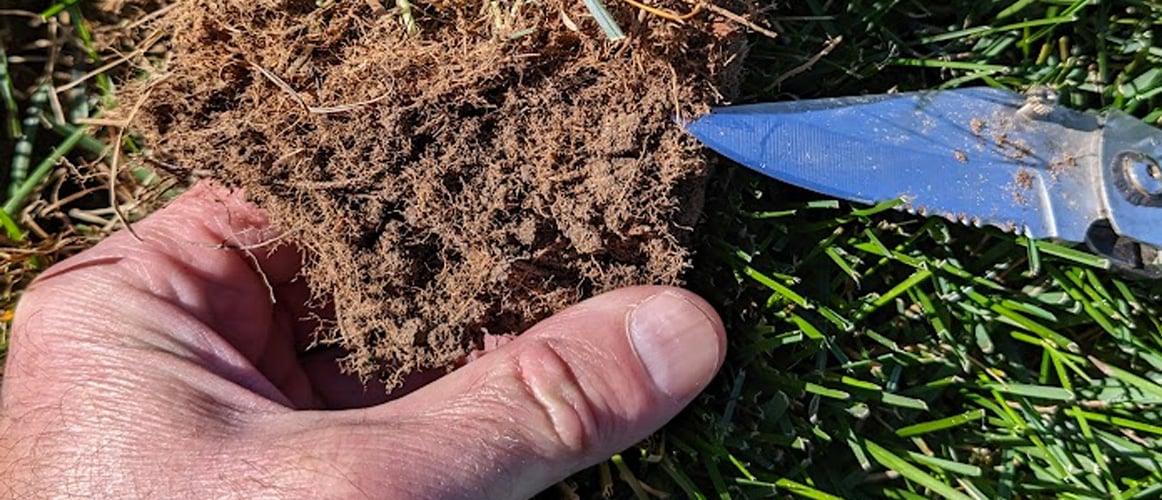There are a number of factors which contribute to thatch production. Some of the simplest are turfgrass varieties. Those which produce more stolons or rhizomes tend to be more susceptible.
In other words, more of the sod-forming grasses will likely be prone to thatch. Several other factors are involved including earthworms and soil microbes which will naturally help decompose organic matter and are affected by poor and compacted soils. pH also has a hand in the soil’s natural ability to decompose thatch. When the pH is at or around 6.5, earthworms and beneficial bacteria thrive and perform their best in the battle against thatch.
Thatch is generally composed of crown, sheath, and stem material. This is the time to dispel the myth of clippings. When maintained properly and the 1/3 rule of mowing is followed, clippings tend to not contribute to thatch accumulation. Clippings are broken down rapidly and do not persist in the thatch layer. In fact, often by returning nutrients to the soil, clipping recycling will improve plant health and soil biology leading to thatch reduction. The key is to manage mowing properly.
When the thatch layer is over 1/2 inches and it is time to act, typically the best and only recourse is physical management processes, including:
- Sand topdressing–The practice of light sand topdressing has been a longstanding means of providing the best playing surface on golf courses. Taking the same route on sports fields and other areas of turf can also help. Sand will help open the layer of thatch to oxygen and moisture which will encourage soil microbial activity leading to thatch decomposition. While effective, it is costly and labor intensive and most times relegated to golf courses and sports fields.
- Dethatching or vertical mowing–This process involves a piece of equipment sometimes called a power rake which uses vertical blades or spring-like tines which rotate perpendicular to the soil surface. They physically scratch and tear thatch away from the soil surface, depositing it on top of the turf canopy for removal. This process is more commonly performed on residential lawns where it can be done more efficiently than some other processes. It can be very effective if the machine height is set properly. The thatch that is removed should be mowed or blown, and then discarded once the process is complete. This task tends to be invasive and somewhat destructive so the current state of turf health should be taken into consideration.
- Aeration or aerification–However you prefer to say it, it means the same, and this is the task that is dreaded by all golfers. It employs a machine that uses cylindrical tines to punch holes through the thatch layer and into the soil surface. There are some options here, and the first is hollow or solid tines. Hollow tines will remove a soil core which is better suited for reduction of compaction in addition to all of the thatch removal and improvement of water and air movement. This does present a second step to the process in breaking up and redistributing the soil cores back into the aerification holes. This is often accomplished with the use of a drag mat or verticut type of machine. Solid tines merely punch a hole without removing a core, which can help with thatch management, but overall this is a lesser solution for improving soil compaction. Some of the other considerations include tine sizing, where bigger is better especially for residential lawns, hole spacing (you can never have too many holes on a thatchy home lawn), and tine depth which you will find more often on much more expensive equipment. The operation of aeration on highly maintained turf is much more of an art. This should give you the basic understanding of what the process entails.
Whichever direction you intend to take, there are some keys to keep in mind;
- Make certain the area to be addressed has been irrigated but is not overly wet.
- Assess the turf health for recovery purposes.
- Choose the times of the year most conducive to turf recovery.
- Following the operation in one to two weeks with a light application of fertilizer (1/4 – ½ Lbs. N) and maintaining deep, frequent irrigation, not allowing the turf to dry out, will speed the recovery.
More recently there has been some research involving sprayable or spreadable products for reduction or prevention of thatch. In any case, applications of materials which improve soil microbial activity can be beneficial in slowing thatch accumulation. Pairing things like EMPRO Aer8tion and EMPRO Soil Enhancer into a program along with some organic fertilizers in place of synthetics can greatly help in the battle against thatch accumulation.
Lastly, one of the biggest influencers is pH. Monitoring and managing pH to keep it in the 6.5 range can go a long way to slow accumulation.
Contact the Ewing Technical Services Team with any questions, and read our other article for basics, Thatch 101: Understanding Thatch.




